Formed in 1885, the Bar Harbor Yacht Club is one of the oldest yacht clubs in New England. Through its windows, five generations of folks who love the water have watched their children learn to sail, their boats ride out storms and the ebb and flow of Frenchman Bay's ten foot tides.

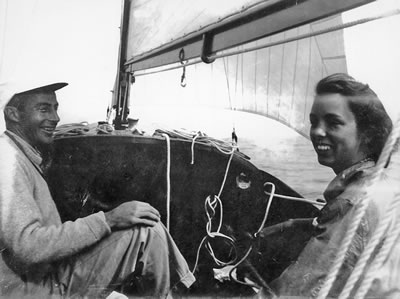
The clothes, cars and hairstyles change over time, but not the reason people come here.
From the Bar Harbor Yacht Club, members and their guests are treated to a panoramic view of Frenchman Bay that is unlike any other in Bar Harbor. Bar Island, the Porcupines, Gouldsboro, Summer Harbor, Sorrento; nearly 90% of the Bay is visible from our pier. Our older members find that with a good pair of binoculars and a comfortable chair, they can watch their grandchildren sail for hours or count lobsters as they are hauled aboard the local fishing boats. Friendly social functions, great views, a sturdy pier and an afternoon sail with your best girl... what could top that?

We're hard to find...
Impossible to forget

Three Buildings: The Quiet Iconoclasm of Robert W. Patterson
William N. Thorndike, Jr.
In the wake of the disastrous 1947 fire, a new, starkly different architecture emerged on MDI. Its pioneer was Bob Patterson, a soft spoken architect with little prior training. Patterson was an iconoclast—actually along several dimensions.
Although a year-round resident of Somesville for over fifty years, he was born near Boston, educated at Harvard College and the Harvard Graduate School of Design (“GSD”) and thus from “away”—a label he would never fully shake. With an unconventional background, he would develop a distinctive modernist style that was perfectly suited to the new, post-fire times and represented a quietly dramatic departure from both his mid-century peers and the architectural antecedents on the Island.
Three of Patterson’s buildings—the Bar Harbor Yacht Club, Garland Farm, and the Abbe Museum addition—vividly demonstrate how this pivot in architectural style played out in the two decades following the fire.
The Context
MDI has an extremely rich and varied architectural history. In 1879 (just as the rusticators were giving way to the cottagers), William Ralph Emerson designed “Redwood” in Bar Harbor— the first shingle style structure in the country. According to Vincent Scully, the long-tenured Sterling Professor of Architecture at Yale, this house was the progenitor of all future cottage style architecture.1 Shortly thereafter, MDI became a beacon for architectural talent, attracting internationally recognized designers ranging from Emerson and Bruce Price (whose recently restored masterpiece “Turrets” sits at the heart of the College of the Atlantic campus) to distinguished regional firms like Boston’s Rotch and Tilden and Andrews, Jaques, and Rantoul and well-regarded Maine architects like Fred Savage and John Calvin Stevens.
From 1880 to 1930, Bar Harbor was a haven for magnates, bankers, and entrepreneurs. Over two hundred elaborate mansions were built during this period, rivaling only Newport among Gilded Age summer communities.2 The original, often elegant, arts-and-crafts influenced cottages gave way during the first quarter of the twentieth century to increasingly ornate structures as Bar Harbor’s reputation as a playground for the wealthy grew.
Many of these early twentieth century houses were absolutely massive and almost defy description, incorporating a polyglot mix of architectural styles from English Country House to Norman Castle to Stratford-on-Avon Tudor with a dizzying array of gables, dormers, turrets, porches, and balustrades. One of the more dramatic later cottages, “Wingwood House,” owned by the Philadelphia banker E.T. Stotesbury, helps make this point. After purchasing a small cottage in Bar Harbor, the Stotesburys engaged in a substantial “remodeling.” The final result, completed in 1927, featured eighty rooms with twenty-eight bathrooms, twenty-six (hand-carved) marble fireplaces, and—most remarkable at the time—fifty two telephones.3 Thorstein Veblen may have had Mrs. Stotesbury in mind when he developed his theory of “conspicuous consumption.”
This exuberant, ostentatious summer community lifestyle evidenced itself in public and civic buildings as well, including Guy Lowell’s Fine Arts Palace, the rambling Kebo Valley Golf Clubhouse, and the elaborate mock Norman Bar Harbor Club (completed in 1929 at the very end of this giltedged era). And this ornate—in some cases borderline baroque—summer house architecture co-existed with the more modest, practical residential and commercial buildings of the year-round community, some of which bore traces of the French-infused Acadian tradition with its snow-defeating, steeply pitched roofs, vertical siding, and deep eaves as protection from harsh off-season storms.
This heady period of lavish building came to an abrupt end with the onset of the Depression. Not a single new cottage was constructed in Bar Harbor after 1931.4 The lively swirl of summer life withered during the Depression and came to a virtual halt during the Second World War. And then in 1947 came the horrific fire that destroyed so much of the town and its surrounding areas. There was nothing gradual or transitional about Bar Harbor’s decline—none of the cottages were re-built.
Like Pompeii, Bar Harbor was a very grand resort that after a short period of decline disappeared virtually overnight. This abruptness has contributed to the ongoing fascination with its heyday and this halcyon period still casts a long shadow. Its remnants and vestiges are everywhere—in lonely grand staircases still visible in the woods off Route 3 and elaborate entry pillars in now deserted, overgrown locations throughout the town and surrounding area. While all architecture is in dialogue with the past, on MDI, as a result of this unique bifurcated history, this dialogue is uniquely intimate.
The two decades following the fire was a time of dramatic downsizing, of straitened circumstances, and it required a new type of architecture—one that was informed by the new, more constrained economic realities of the times and the sudden related change in tastes. This new style was provided by an unlikely revolutionary—a young transplant from Boston who had actually been trained as a landscape architect and held no formal
architectural degree. He would develop a distinctive brand of regional modernism that uniquely met the needs of those uneasy times.
Robert W. Patterson
Robert Whiteleigh Patterson was born in 1905 in Wayland, Massachusetts, then a largely rural community about fifteen miles west of Boston. The family property was located near the town lines with Lincoln and Concord and set on sixty acres of woodland. Patterson was the youngest of four children and spent much of his time in the surrounding woods camping, sledding, cross-country skiing, collecting insects, and playing capture-the-flag games with the neighbors.5 These formative years kindled a lifelong love of the outdoors.
According to the Harvard University Archives, Patterson graduated from Harvard College in 1927 and then in 1932 from the Harvard Graduate School of Design with a master’s degree in landscape design. In 1931, he married Barbara Brown, a Wayland native who was seven years his junior and a talented ornithologist.
In January 1934, in a driving blizzard, Patterson, Barbara, and their baby daughter moved to MDI, drawn there by a combination of the Island’s stark natural beauty, relatives of Barbara’s in Southwest Harbor, and the prospect of design work with the Civilian Conservation Corps (“CCC”), which was based in Ellsworth and engaged in numerous projects in Acadia National Park.6 For a recent graduate of the GSD, this decision to relocate to remote MDI in the depths of the Depression was highly unconventional.
At the CCC, Patterson designed two landmark trails on the rugged western side of the Island: Beech Cliffs and the Perpendicular Trail. Both are regarded today as masterpieces. He also began to work on projects with the renowned landscape designer Beatrix Farrand and the Park’s head architect, Benjamin Breeze, including a hilltop swimming pool for mystery writer Mary Roberts Rinehart in Bar Harbor and the wonderful Fabbri Memorial in Otter Creek.7
After the war, Patterson began to build his own architectural practice. He worked out of a small office in the old YMCA building on Mount Desert Street in Bar Harbor, now the Abbe Museum. He had virtually no staff and executed the designs and drawings himself.8
The 1947 fire was disastrous for Bar Harbor and surrounding MDI communities but, as with Christopher Wren after the Great London Fire, it was an undiluted boon for Bob Patterson’s practice, and he would go on to design a wide variety of buildings over the next thirty plus years. In all, he designed sixty houses—forty-two of them on MDI, another sixteen elsewhere in Maine (generally in concentric circles radiating out from MDI), one in Massachusetts, and one in Connecticut. He also designed over forty additions to existing structures and over forty non-residential buildings, including libraries, museums, club buildings, parish houses, and the occasional town dock.9
Like a small town doctor or lawyer, Patterson was a jack-of-all-trades and worked on a dizzying variety of projects ranging from a church steeple in Blue Hill to a doghouse in Manset. He also designed fences and lamps, banisters and gravestones, and wonderful furniture—particularly tables and benches.10
Patterson may have been an intensely local architect, but he had a remarkably cosmopolitan client list. In architecture, as in any service industry, the ultimate measure of success is repeat customers, and the list of clients for whom Bob Patterson completed multiple projects includes the Rockefeller family, Mrs. Vincent Astor, the Pulitzers, Saltonstalls, and Millikens, as well as Samuel Eliot Morison, Casper Weinberger, Walter Damrosch (conductor of the New York Philharmonic), the Madrid Bureau Chief for the New York Times, and the Farrands. He also worked with scientists (including Earl Greene, the legendary head of the Jackson Laboratory), restaurateurs such as the Testa family, and a wide range of year-round residents.11 These were sophisticated clients who twenty years earlier might have been building substantial cottages, but they now turned to Patterson for very different types of buildings. They had other design options, and they chose to work repeatedly with Bob Patterson.
His practice thrived throughout the 1960s and into the late 1970s when he “retired.” He still, however, took on occasional projects; his last two designs from the mid-1980s included an outbuilding for Casper Weinberger in Northeast Harbor and a remarkable home in Somesville for his son Lee. He died in 1988 at the age of eighty-three.12
An Unusual Influence: Landscape Architecture and Beatrix Farrand
There are two aspects of Patterson’s career that an architectural historian would find particularly unusual. The first was his formal training in landscape architecture. It’s very rare for architects today to have any background in landscape design; in fact, many of the top architecture schools have dropped the subject from their curricula. For Patterson, however, landscape architecture was central to his career. (In the 1970s he was instrumental in initiating a certification process for landscape designers in Maine, and he held license #1 in the state.)
The other unconventional aspect of his career was that he never served a formal apprenticeship with a master architect. The closest he ever came to such an arrangement was in his long relationship with Beatrix Farrand, with whom he worked closely from the mid-1930s until her death in 1959. Farrand could be prickly, but she and Patterson got along exceptionally well and collaborated on a wide variety of projects including Dumbarton Oaks, the renowned garden outside of Washington, D.C., and the University of Chicago campus.13
All of which raises a legitimate question: how can an architect be influenced by a landscape designer? Farrand liked to refer to herself as a “garden designer” but she didn’t just design gardens. She pioneered a holistic approach that emphasized the design of the entire property, and she was masterful at integrating her designs into the landscape. Patterson was deeply influenced, in particular, by her extensive use of native plants and by a broader aesthetic that emphasized the importance of blending into natural surroundings. This aesthetic would become central to his work. As his son Lee summarized it, “My father’s goal was always to have his buildings fit their surroundings as closely as possible.”14
In fact, Patterson is an important link in a much longer landscape design lineage that stretches back through Farrand to the end of the nineteenth century and her key influences, including the British garden designer Gertrude Jekyll, and then extends forward to such current MDI practitioners as Patrick Chassé and Dennis Bracale. Excellent examples of Patterson’s landscape design include the Fabbri Memorial in Otter Creek, Somesville Landing near the top of Somes Sound, and the Damrosch family plot at Ledgelawn Cemetery in Bar Harbor.
Other Influences
With his lack of conventional training, Patterson was outside of the architectural “academy,” and this distance helped him to retain fresh eyes and perspective—leaving him open to new ideas and influences. In addition to Farrand, these early influences included:
- The architecture near his childhood home in Wayland, including Thoreau’s minimalist structure at Walden Pond in Concord—an archetype of Yankee pragmatism, and the collection of stark, “International Style” modernist houses built in the late 1930s in neighboring Lincoln by Bauhaus immigrants Walter Gropius and Marcel Breuer when they joined the Harvard faculty after fleeing Nazi Germany.15
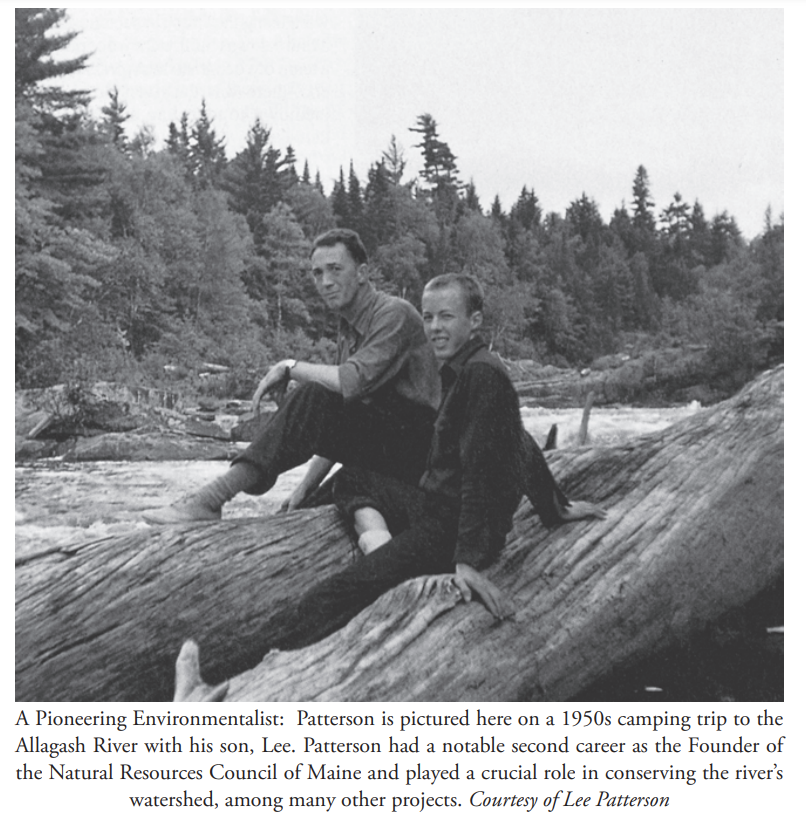
- Two early MDI modernist houses from the 1930s: “Tide Race” in Somesville and the remarkable “Fortune Rock” at the very top of Somes Sound, both designed by Yale School of Architecture Dean (and former Louis Kahn partner) George Howe.16
- Benjamin Breeze, the head architect of Acadia National Park, who drew on local, vernacular traditions to evolve a distinctive “neo-Acadian” style for the still new park—epitomized by the Thunder Hole Ranger Station built in 1933, the year before Patterson arrived on MDI.17
The Patterson Style—A New Modernism for MDI
In architecture, as with other modernist movements (Cubism, Surrealism, etc.), there came a point where the core principles fanned out from their point of origin (continental Europe in the case of “International Style” modernism) into the broader culture, and in this process of geographic spread were influenced by and had to reckon with local, vernacular materials and aesthetic traditions. This interaction often produced provocative new works—the architectural equivalent of “terroir” for wine—a pungent sense of locale. Patterson is firmly, if idiosyncratically, in this tradition of regional modernism.
Born of a time of scarcity and frugality, Patterson’s was an architecture of modesty and restraint, of subtlety and pragmatism. His structures tended to be single story, low slung with overhanging eaves—more bungalow than cottage—calling to mind elements of Frank Lloyd Wright’s Prairie houses (the Robie House, in particular) or the Porcupine Islands in Frenchman Bay. They certainly did not evoke their famous, often hulking cottage predecessors; they were clean and crisp, and they did not ramble. Patterson had a low key, understated demeanor, and as with most architects, his style reflected his personality. His buildings don’t look like other modernist structures; they are warmly minimalist, and they tread lightly on their sites. One of their distinctive elements is an extreme sensitivity to site and setting, an intentional inconspicuousness—the antithesis of today’s “starchitecture.” As you approach a Patterson building, there is a balance between landscape and architecture and your eye takes in the whole of the relationship between structure and site. An early expression of this aesthetic can be found in a memo he sent to his CCC supervisor on the design of the Beech Cliffs trail: “[O]ne of the most important requirements . . . is that [the trail] looks harmonious and unobtrusive in its surroundings.”18
Patterson was an outsider in relation to other mid-century “International Style” modernists, in part because of his avoidance of modern “technological” materials like steel and cement. He preferred to use natural materials, especially woods and local stone, and muted colors—blues and grays and browns. His buildings were most definitely not the “machines for living” that the Dutch modernist Mies van der Rohe had called for. Yet they did embody a sense of function and practicality, an avoidance of flourish and ornament that was highly consistent with modernist principles. As a result, in the taxonomy of modernist architects, Patterson is far removed from the more antiseptic steel-and-glass purists—the Corbusiers and van der Rohes and Johnsons. His work has a much closer affinity to that of Wright and Alvar Aalto, the Scandinavian modernist whose designs featured softer, warmer woods and organic designs reflective of their Nordic settings. (Another parallel can be found in his near contemporary, the Italian architect Carlo Scarpa, who had a similar outsider relationship to the much older, more ornate Venetian aesthetic tradition—and a similarly unconventional background, having begun his career as a glass designer.)
Board and BattenThe cottages tended to have two or three stories and to balance this upward thrust with horizontal siding (usually shingles). Patterson turned this convention on its head; his houses were relentlessly horizontal, with Acadian-influenced vertical siding—often battens, and to illustrate the interplay between these two strands—the vernacular and the modern—it’s instructive to look at what Patterson did with the lowly batten. Board and batten is among the simplest, least expensive forms of construction. It involves the use of thin wooden strips or “battens” arranged vertically to seal the seams between boards in a distinctive, raised pattern. It is often associated with Acadian architecture and with barns and inexpensive outbuildings, and it is common throughout southern Canada and northern New England. Early in his career, Patterson recognized the design potential in this seemingly mundane material. His inspiration was to use battens on houses and public buildings and to transform them into an elegant, recognizably modernist decorative element by the use of beveling to create sharp, raised edges that held light and created contrast and texture. A version of this technique was utilized in the mid-1950s by Wallace Harrison (architect of the United Nations building in Manhattan) for the Burden house in Northeast Harbor. |
|
|
Following pioneering Austrian modernist Adolph Loos’ dictum that “ornament is crime,”19 Patterson’s architecture was without frill or fuss—almost Shakerite or Japanese in its simplicity and humility and use of local materials. His buildings have a clean, spare feel, but achieved with lighter,
natural materials.
Patterson, like all architects, can also be defined by what he generally avoided: second stories, skylights, shingles, clapboarding, air conditioning (although he was a pioneering user of radiant heat), dormers, exterior steel or cement (not to mention the weather-vanes, pediments, pillars, castle elements, etc. of his early twentieth century predecessors). His buildings do not call attention to themselves; they are low ego and in their use of local materials, their attention to siting, their use of natural light and ventilation, they presaged many of the tenets of today’s “green” architecture movement—long before such terms as “sustainable” and “low impact” were in vogue. Collectively, they represent a stark contrast with the pages of Lost Bar Harbor.

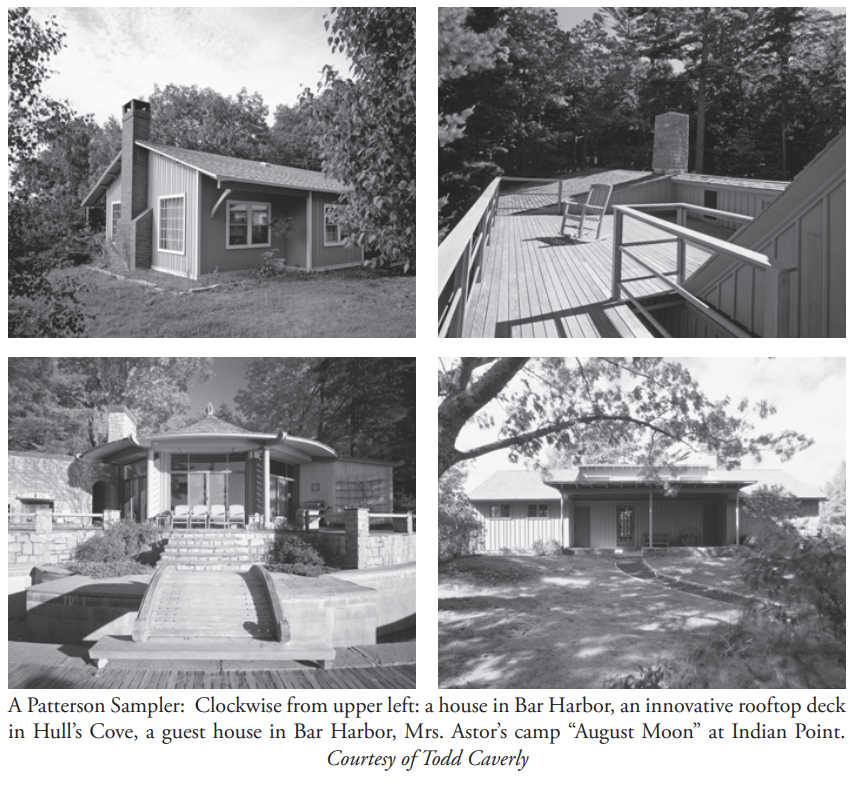 Three of Patterson’s buildings from the 1950s and 1960s illuminate the ways in which his distinctive style fit so well with the Island’s needs after
Three of Patterson’s buildings from the 1950s and 1960s illuminate the ways in which his distinctive style fit so well with the Island’s needs after
the fire. Two of these are public facilities, one a private residence, each shows Patterson’s unique strain of modernism addressing a specific set of challenges; each also departs dramatically from its predecessors.
Bar Harbor Yacht Club (1954)
Started in 1924, the Bar Harbor Yacht Club (“BHYC”) was originally housed in the former Reading Room of what is now the Bar Harbor Motor Inn. In the early 1950s, the town decided to turn the Reading Room into a hotel, and the BHYC was forced to find a new site. Some capital for the new structure was provided by the Jenkins family after their son, Jerry, drowned tragically in Frenchman Bay in 1952.20 The Yacht Club’s board settled on the only remaining site in the Bar Harbor area with water access: a tiny, postage stamp-sized lot at the base of a steep hill off Route 3
about a mile north of town. The property was located near several massive, decaying cottages including “Sonogee” and “East of Eden.” Their grandeur would stand in stark contrast to Patterson’s eventual design.
Faced with the restraints imposed by a tight budget and claustrophobic site, Patterson’s design featured a single, large, open room with a pitched roof, dominated by an oversized fireplace and chimney in local fieldstone (a possible nod to Marcel Breuer) wreathed with windows and pointed towards the top of Frenchman Bay. The room also featured wonderful built-in furniture to promote conviviality and sociability. Attached to this central space, he placed two smaller wooden cubes containing the kitchen, bathroom, and storage. These cubes were highly modernist in shape and form (Mies would have approved) and supported in part by a thin, Corbusier-like steel column. The outside was painted a subtle gray and featured a trademark board and batten exterior.
The building is accessed through an innovative telescoping system of sliding glass doors and the first impression is of entering a light box. BHYC
is “light” in both senses of the word; small and low slung and constructed of wood, it is light on its feet and has a lot less grandeur than traditional
yacht clubs. Also, by virtue of the large windows on its East, North, and West sides, it is infused with natural light. (David Hackett Fischer, the
Pulitzer Prize-winning historian, refers to these crisp, light-filled Patterson designs as “jewel boxes”).21
Of these three buildings, the BHYC is his most “modernist;” the structure is a drastic departure from its giant neighboring predecessor cottages and from the very idea of a yacht club. It is small and cubist and porchless, cozy and functional, and perfectly fitted to its site. As Scott Koniecko, an architect who has overseen two recent Patterson renovations, commented, “Great architecture solves problems so completely there is no evidence a problem ever existed—which is exactly what Bob did with the almost impossible BHYC site.”22
Garland Farm (1955)
By the mid-1950s, despite Beatrix Farrand’s best efforts, it was clear that her plan to build an international center for landscape design and education at Reef Point was no longer financially viable. Faced with this reality, she made the difficult decision to sell the property and move to a more modest home near Salisbury Cove. For Farrand, who was eighty at the time, the decision to sell the large cottage at Reef Point was an extraordinarily difficult one. It was both her ancestral home and a lifelong family refuge. To ease the pain of this decision, she selected the most meaningful elements from the house (including windows, fencing, balustrades, and the iconic, Asian designed front door) and brought them with her to her new home.
She was moving to Garland Farm, a property owned by her former caretaker’s family, where she planned to build a small house.23 To help her with this, she turned to her long-time colleague. This presented a unique challenge for Patterson, who had to integrate the Reef Point items into a tiny building site nestled between two existing nineteenth century structures—a small farmhouse on Route 3 and a large barn behind.
Patterson designed a simple, compact structure with three main rooms: two bedroom suites on either side of a common living room, all with enormous windows and French doors, opening onto a small, private, southern-facing garden plot. He adjusted his approach to the demands of the site, designing a system of flat and pitched roofs that tied into the house and barn’s existing roof lines while also giving a hint of modernist flair. He successfully integrated the fences, balustrades, and roofing into a distinctive design that managed both to fit with the existing vernacular structures and, at the same time, leave its own trace of crisp minimalism. In particular, he succeeded in making the unique aquamarine Asian front door from Reef Point somehow seem as though it had been there forever.
Farrand loved Patterson’s design and lived out her last four years in this spare, secluded gem of a house—writing, puttering in the garden, and
hosting friends. These final years were among the happiest of her life.24
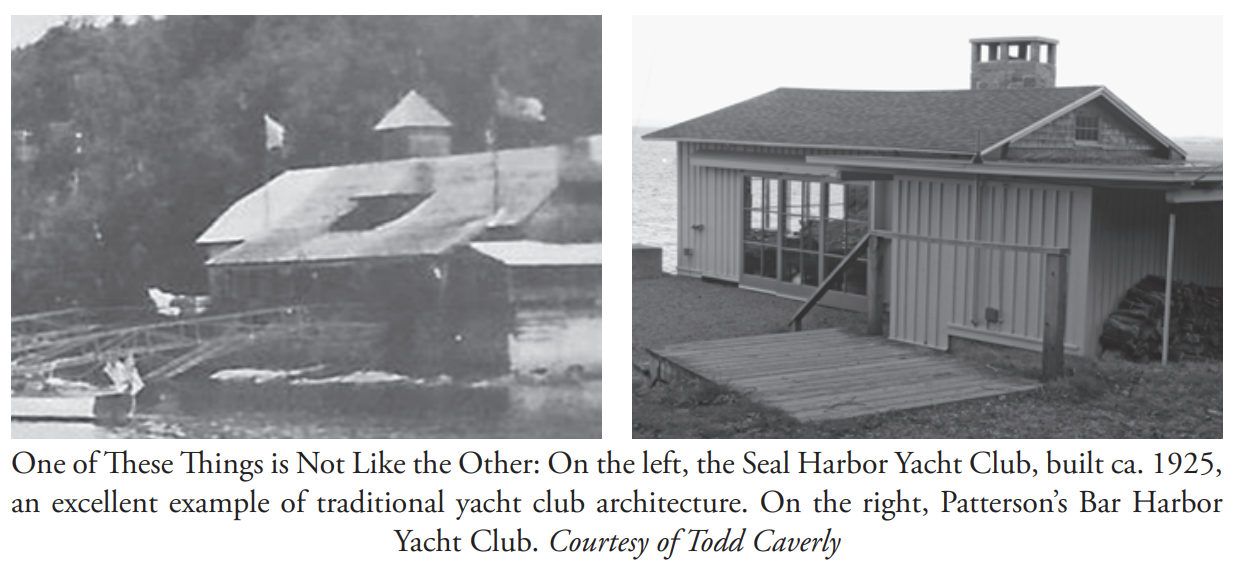
Abbe Museum Addition (1967)
Guy Lowell was an internationally known architect whose major works included the Museum of Fine Arts in Boston and the innovative New York Supreme Courthouse in Manhattan. He had designed the ornate, classically influenced Palace of Fine Arts in Bar Harbor in 1911 as well as numerous landmark summer houses on the Island (including “East of Eden” near the eventual site of the BHYC).25 In the mid-1920s, Lowell was tapped by the wealthy summer resident Dr. Robert Abbe to build a permanent home for his burgeoning collection of local Native American artifacts. For Abbe’s museum, Lowell designed a simple vestibule entrance attached to a much larger exhibition space with fourteen-foot ceilings. For this space he chose an unusual, powerful form with classical connotations: the octagon.
Lowell sheathed the building in stucco with Spanish tiles on the roof, capped by a cupola with an ornate pineapple at its tip. The external walls featured elaborate bands of molding broken by occasional floral designs in stone. The building almost overnight became one of the most admired civic buildings on the Island. (Abbe sadly died just before the building was completed).26
In the mid-1960s, the Abbe board of trustees asked Patterson to design an addition to provide more office space. He was faced both with the interesting generic challenge of adding to a landmark building and also the specific one of how to connect his structure to such a unique shape. There is an entire literature on museum additions, as they provide uniquely interesting opportunities for juxtaposing architectural styles. The approaches to the problem of how to add to these often iconic buildings have varied widely, with solutions ranging from overt mimicry to wildly different structures. At the Abbe, Patterson chose an intermediate path—a respectful, but distinctly modernist solution.
His building is a restrained, elegant echo of Lowell’s distinctive stone structure: a sleek wooden octagon painted gray with simple, elementary, modernist bands on the external walls and clerestory windows to bring in natural light and Dorr Mountain views behind crisp rectilinear grids with subdued red highlights. Patterson’s structure was also capped by a cupola—significantly, one without a pineapple. The building was designed with Patterson’s characteristic modesty; located directly behind Lowell’s structure, his addition is so subtle it cannot even be glimpsed from the front. Today it is rarely seen except by those en route from Sieur de Monts to the Tarn and Dorr Mountain hiking trails.
The Abbe addition further cemented Patterson’s distance from the architectural fashions of the day. In the mid-1960s, when he was working on this design, International Style modernism had given way to the excesses of “Brutalism,” a blunt style that featured large, unadorned concrete masses (think Boston City Hall). It’s hard to imagine a less brutal design than Patterson’s subtle addition.
Conclusion
Each of these buildings shares a common aesthetic, a language. They are distinctly “Pattersonian,” embodying a fundamentally different set of solutions than any other architect would have arrived at. With all three buildings, Patterson had to grapple with the legacy of MDI’s storied halcyon period— the Reef Point cottage elements and two nineteenth century structures at Garland Farm; the neighboring mansions and yacht club architectural norms at the Bar Harbor Yacht Club; and Lowell’s iconic structure at the Abbe. It is hard to imagine a more dramatic collective departure from the elaborate architecture of the first third of the twentieth century.
Each could have been an out-building for some of their grander predecessors; each is also an excellent example of Patterson’s subtle minimalist style. All three projects were executed on very tight budgets and on challenging small sites. All three embody a combination of warmth and practicality, modesty and restraint, and a deep sensitivity to the landscape. Collectively, these buildings show how one man dealt with the challenges posed by the Island’s illustrious past and the realities of a new, less gilded era—a process representative of an entire community’s adjustment following the ’47 fire.
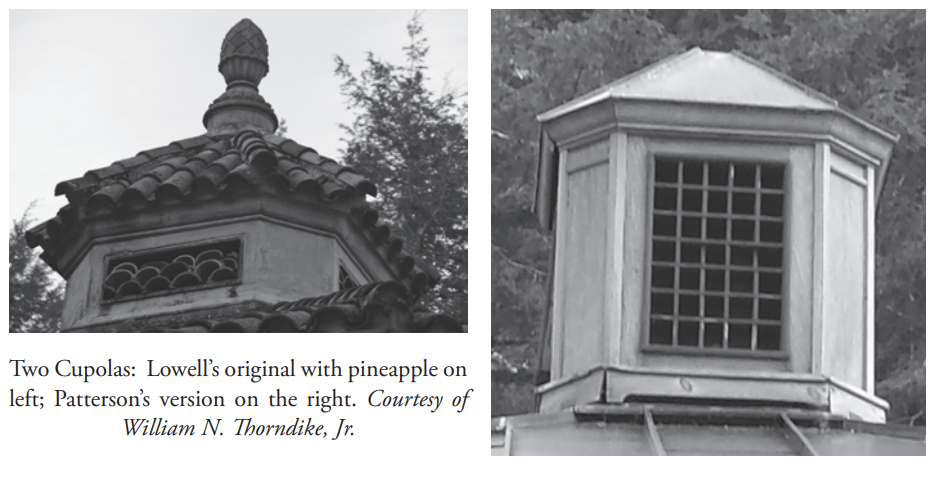
Notes
1. Vincent Scully, Jr., The Shingle Style and the Stick Style (New Haven: Yale Publishing in the History of Art, 1971), 84.
2. Giles Helfrich and Gladys O’Neill, Lost Bar Harbor (Camden: Down East Books, 1982), 9.
3. Ibid., 74-75.
4. Ibid., 9.
5. Robert W. Patterson, Oral History, Collection of the Wayland Historical Society.
6. Author conversations with Lee Patterson, August 2007 – August 2011.
7. Robert W. Patterson, “List of Clients & Projects,”1985. Mount Desert Island Historical Society.
8. Author conversation with Lee Patterson.
9. Patterson, “List of Clients & Projects.”
10. Ibid.
11. Ibid.
12. Lee Patterson, obituary of Robert W. Patterson (front page), Bar Harbor Times, February 22, 1988.
13. Patterson, “List of Clients & Projects.”
14. Author interview with Lee Patterson, August 2011.
15. Author conversations with Lee Patterson, August 2007 – August 2011.
16. Ibid.
17. Ibid.
18. Author conversation with Jack Russell, April 2009.
19. Adolph Loos, “Ornament and Crime” (Riverside, California: Ariadne Press, 1997).
20. Author interview with Scott Koniecko, October 2013.
21. Author interview with David Hackett Fischer, August 2012.
22. Author interview with Scott Koniecko, October 2013.
23. Ibid.
24. Ibid.
25. Author interview with Scott Koniecko, October 2013.
26. Wikipedia.org, accessed February 8, 2014.



